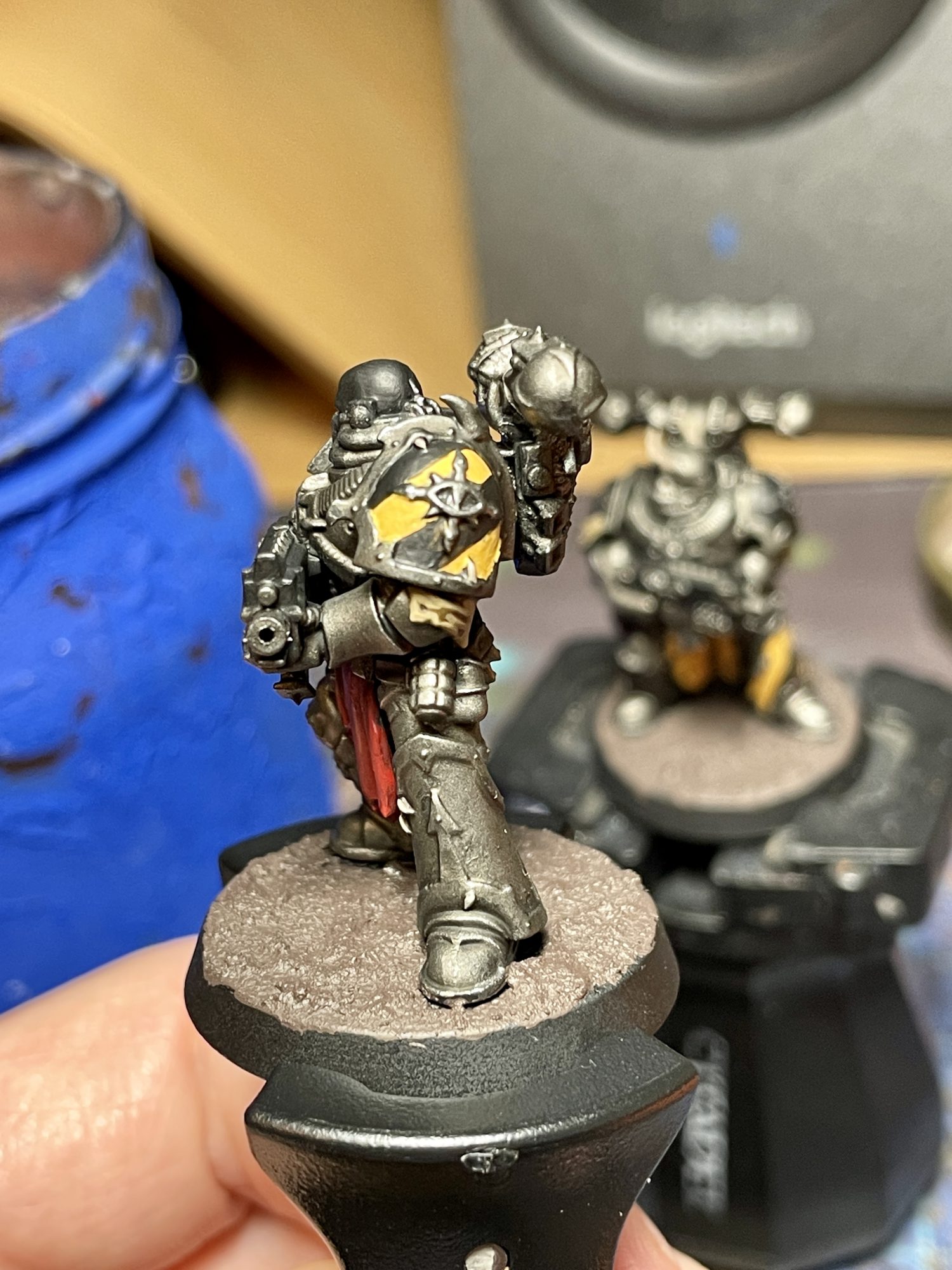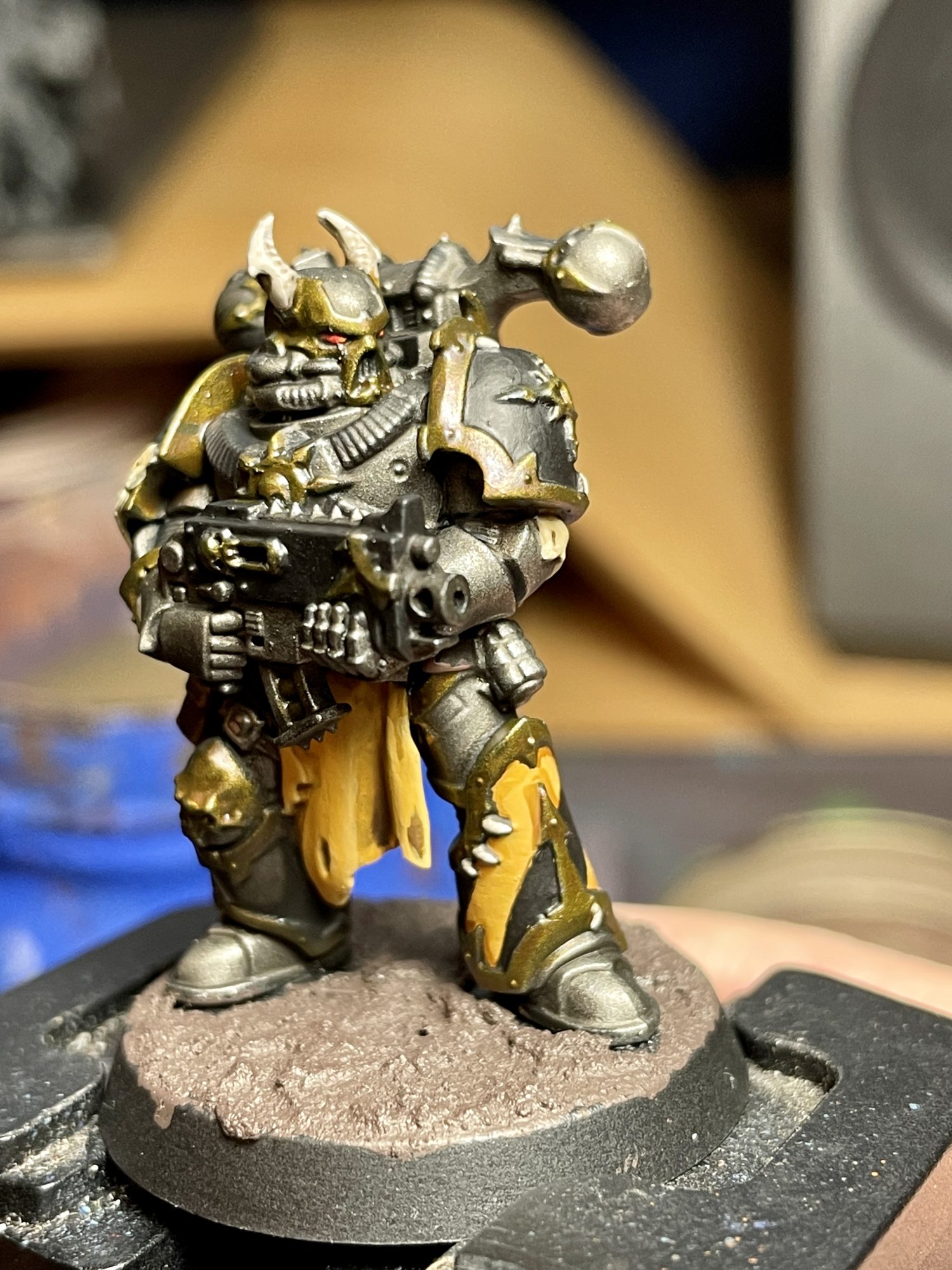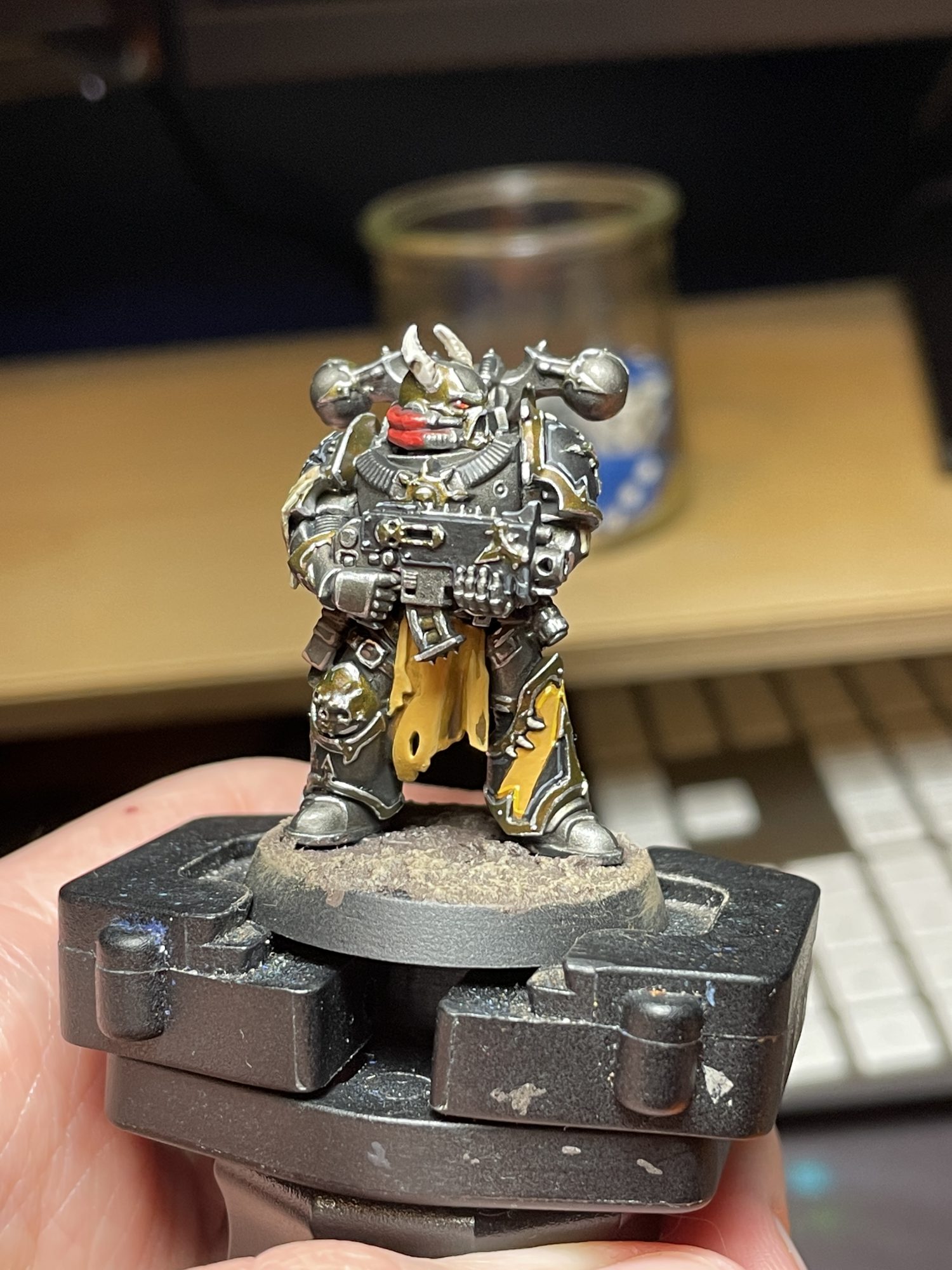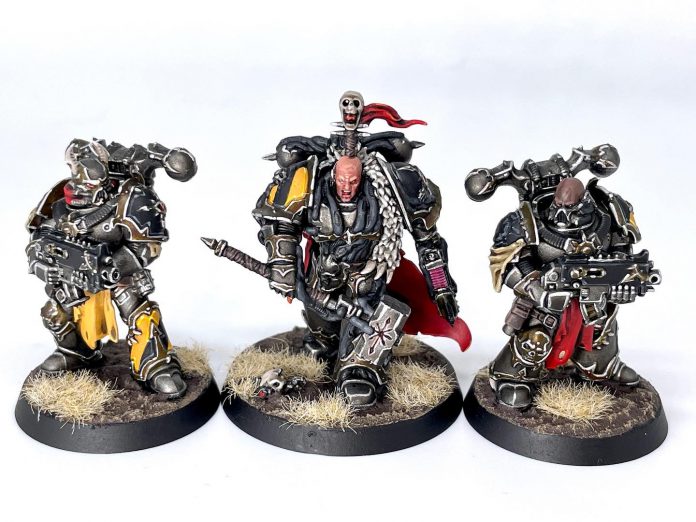In our How to Paint Everything series we look at how to paint well, everything, with different methods, approaches, and painters. In this article we’re looking at how to paint the traitorous forces of the Iron Warriors for Warhammer 40k and The Horus Heresy.
SRM
Hey, it’s me, the guy who writes a painting tutorial before actually painting anything! I have this awful habit of writing a painting tutorial completely off the dome, then going back and following it, adjusting as needed. It’s not a good process, but it’s my process.
This will be working from black primer. You could use Leadbelcher primer instead, but I find it dries kind of glossy and washes slide off it. We’re also going to be going darker than Leadbelcher, but if you really wanted to use it instead of Iron Warriors I can’t stop you. I’m neither a cop nor your dad, so do what you will.

Appropriately, we’re going to start by painting the whole miniature with Iron Warriors. Don’t worry about getting onto other details, you can be sloppy with it. We’ll follow that by popping on our basecoats for the leather, cloth, bone, and other details, then slathering the whole mini in a 50/50 wash of Nuln Oil/Agrax Earthshade. Mixing these two gets an oily, dark and dirty look. You could do one then the other but it’ll double your drying time, and I want to get these guys on the table fast. Once the wash is all dry we can go back and start layering and highlighting up each of the previous colors, then take the time to fill in the black and yellow details.

We’ll begin by going back and blocking in all the areas we want to be black or yellow. For hazard striped areas like the field on the pauldrons (and potentially greaves and gun casings if you’re feeling spicy) paint them with Averland Sunset. It’s easier to paint black over yellow than it is to paint yellow over black. It’ll probably take 2-3 coats. You can then take thinned black (I use P3 Thamar Black, but GW’s Abaddon Black will do) and lightly paint the lines where you want the hazard stripes to be. Fill them in with black, clean them up if need be, and do a recess shade of Seraphim Sepia on the yellow. You can then highlight with Yriel Yellow, followed by Dorn Yellow for the sharpest points. The black should be highlighted with Eshin Grey then Dawnstone, following the same techniques. For more detail on painting hazard stripes and such, we wrote a great article with loads more methods.
Black areas can simply be blocked in with your black paint of choice. This is generally going to be one or both pauldrons and the weapon casings. As the legion badge sits on the left pauldron, it’s usually a good shout to put down a more plain color so it won’t look so cluttered if you freehand the Iron Warriors symbol or slap a decal down there. Highlight the black as detailed in the caution stripes step above.
There’s often some cloth or hair floating around, like loincloths, capes, topknots, or some other textural elements. As the Iron Warriors scheme is heavy on neutral colors, it’s a chance to get a pop of color in there without straying too far from the established color palate. For yellow cloth, I base with Averland Sunset to tie it in with the hazard stripes. For red cloth, I base with Mephiston Red, which ties in with the eye lenses and weird Chaos tubes. Lastly, for a more neutral cloth, I base with Zandri Dust. These all get knocked down by the 50/50 Nuln/Agrax wash, so we’ll bring them back up to their base coat and layer up by mixing in lighter shades of yellow, red, and tan respectively. You could just go straight to highlighting instead, but I like layering cloth up – it’s relaxing and a nice break from sharp edge highlights. The specific colors I use are further down this article but the method is what’s most important.
Teeth and bone find their way onto Chaos models on the reg. We’ve already based these areas with Rakarth Flesh and washed them with that same all over 50/50 Agrax/Nuln mix, so let’s brighten them back up. Using Rakarth Flesh, go back and highlight all that osseous detail, then mix in gradually more Flayed One Flesh for increasingly raised areas. I like doing a final highlight of Flayed One Flesh for any sharp edges.

Contrast paints are going to be your friends for a lot of the details here. First, use Black Templar on all the ribbing in the joints, all the ribbed pipes, grilles, vents, and so on. It’ll help make those pipes stand out from the dark steel of the armor, and add some depth and a blackened effect to things like the backpack vents. Next, it’s the real magic trick of this whole process – Nazdreg Yellow on all the trim. Painting and highlighting the trim is always the biggest pain in the butt on Chaos models, but one coat of Nazdreg Yellow over the dark steel we’ve already established will give you a dirty gold that fits perfectly with the Iron Warriors aesthetic. If there’s any other gold you want to put on the model, like some of the random Chaos icons, hanging baubles, or what have you, this is still the go-to method. Just be careful and don’t bother thinning it down at all, as we don’t want it flowing elsewhere on the model. If you spill over a little, be quick and soak it up with a brush.
Invariably you’ll run into lenses – eyes, weapon targeters, those cool cyber-monocles, whatever. Base these with Mephiston Red, and highlight the bottom half of the lens with Evil Sunz Scarlet. Now highlight the very bottom edge with Fire Dragon Bright. Then in the furthest corner from these highlights, use a tiny amount of that same 50/50 wash to darken a round area at the top of the lens. Put a tiny dot of White Scar in that darkened corner. On eye lenses, do the same process but with the white dot appearing on the far outside corners, and the oranges concentrating towards the center of the face. You could do that darkened dot in a darker red or even a black, but I’m trying to be quick here.
There are these fleshy tubes that find their way onto Chaos models which I’m not exactly buckwild about. They’re kinda gross and usually have some mechanical ribbing, but there’s a few ways you can go about painting them. My first attempt was Mechanicus Standard Grey with Black Templar Contrast paint, then a soft highlight of Eshin Grey on the most raised areas. This lacked lower-case-c contrast with the steel of the armor, so on my second attempt I went for red instead. Starting from Mephiston Red, I washed it with the same 50/50 Nuln/Agrax wash I love to use so much, then highlighted it back up with Mephiston Red. I mixed in just a smidge of Wild Rider Red for some of the sharper highlights on it, but I really don’t like these details so I didn’t spend too long on them.

Lastly, it’s time to highlight all the metals. This is the longest part of the process, but the one that makes all those details pop and brings the scheme together. I went with Stormhost Silver, as I wanted to maximize the contrast and definition of these models. Normally I’d do some weathering too, but these models are already so busy that adding scratches and such just seems like it would be too much.
Tying it all together, I went with a pretty neutral muddy base with some Galeforce Nine dead grass I bought in 2008. The basing was just Stirland Mud with successive drybrushes of Steel Legion Drab and Karak Stone, with a final coat of black around the base rim.
Thing (Location):
- Paint color
Dark Steel (Armor):
- Iron Warriors
- 50/50 Nuln Oil/Agrax Earthshade wash all over
- Edge Highlight Stormhost Silver
Ribbing (Joints, vents, grilles):
- Iron Warriors
- 50/50 Nuln Oil/Agrax Earthshade wash all over
- Black Templar
Dirty Gold (Trim):
- Iron Warriors
- 50/50 Nuln Oil/Agrax Earthshade wash all over
- Nazdreg Yellow
- Edge Highlight Stormhost Silver
Black (Gun casing, shoulder pad field):
- P3 Thamar Black
- Edge Highlight Eshin Grey
- Extreme Edge Highlight Dawnstone
Leather (Straps, holsters):
- Dryad Bark
- 50/50 Nuln Oil/Agrax Earthshade wash all over
- Edge Highlight Gorthor Brown
Bone (Horns, skulls, uhhh femurs I guess? ):
- Rakarth Flesh
- 50/50 Nuln Oil/Agrax Earthshade wash all over
- Layer back up to Rakarth Flesh, leaving the wash in the recesses
- Edge Highlight Flayed One Flesh
Hazard Stripes (Shoulders, greaves, wherever):
- Averland Sunset
- Paint thin lines in thinned P3 Thamar Black
- Seraphim Sepia recess shade
- Highlight yellow with Yriel Yellow
- Highlight the sharpest yellow areas with Dorn Yellow
- Highlight black with Eshin Grey
- Highlight the sharpest black areas with Dawnstone
- Sponge on Rhinox Hide
Neutral Cloth (Tabbards, cultist uniforms):
- Zandri Dust
- 50/50 Nuln Oil/Agrax Earthshade wash all over
- Layer back up to Zandri Dust, leaving the wash in the recesses
- Blend up to Ushabti Bone, mixing gradually more Ushabti Bone in with each pass
Red Cloth (Tabbards, spicy cultist uniforms):
- Mephiston Red
- 50/50 Nuln Oil/Agrax Earthshade wash all over
- Layer back up to Mephiston Red, leaving the wash in the recesses
- Blend up to Wild Rider Red, mixing gradually more Wild Rider Red in with each pass
Yellow Cloth (Tabbards, pissboy cultist uniforms):
- Averland Sunset
- 50/50 Nuln Oil/Agrax Earthshade wash all over
- Layer back up to Averland Sunset, leaving the wash in the recesses
- Blend up to Yriel Yellow, mixing gradually more Yriel Yellow in with each pass
Lenses (Eyes, targeters):
- Mephiston Red
- 50/50 Nuln Oil/Agrax Earthshade wash all over
- Evil Sunz Scarlet, concentrating on the inner edges of the eyes, lower corner of a round lens
- Fire Dragon Bright, at the very sharpest corner of the inner edges of the eyes, lowest corner of a round lens
- White Scar dot in the far back corners of the eyes, upper opposite corner of the previous highlights on a round lens
Thanqol

I love hazard stripes, but I do not want to fuck around with tape, airbrushes, or anything that breaks me out of the rhythm I have with my brush. Turns out that there’s a trick to doing hazard stripes freehand: weather the shit out of everything.
Those hazard stripes are not entirely straight. They’re freehanded, and you can see if you look closely that they are neither parallel nor evenly spaced. That’s fine, actually, because the miniature has so much visual confusion from the heavy weathering that the lines are broken and your mind barely notices it. The transfers are especially essential to this formulae – they provide such pops of visual interest that they command the eye to focus on them and not the imperfections on the hazard stripes.
The yellow is Averland Sunset base, washed sloppily with agrax earthshade, highlighted with usabti bone and screaming skull. The black is Corvus Black highlighted with eshin grey and stormvermin fur. The metal is Iron Warriors washed with nuln oil and drybrushed with necron compound. The transfers go on at this stage. That part is simple.
The fun part is the weathering. I sponge-stippled rhinox hide on heavily, focusing on areas where I was unhappy with any errors in my diagonal lines, and then did a second and more limited stipple with Abaddon Black. Then I went back to usabti bone and did small higlights on the *lower* part of some of those black patches. Dark area+lower angle highlight scans as a metal scratch to the eye. Then, after that stage is done, I went over the whole thing with a glaze of seraphim sepia – I didn’t thin it with medium but I applied the layer thinly. In particular, pulling that over the transfers tints them and makes them part of the model.

The other important part with Iron Warriors is that they must be miserable. They have to be down in filthy, broken mud and toxic landscapes and the basing is essential to that. And toxic basing is easy and fun to do, you can really go wild with it.
I started here with just a brown texture paint, washed the whole thing with nuln oil and gave it a very light drybrush of longbeard grey. Then I splashed down some flash gitz yellow around randomly, and then drowned the entire area in a super heavy pool of Iyanden Yellow. Iyanden has an orangey tint where it goes heavy which adds this really hideous, corrosive look when it dries over dark brown. It’s easy and simple and a lot of toxic biomes are easy to do with a similar method. The grass tufts add a lot, though, especially if you can get dry/dead ones – they make it look like the misery only happened to this place recently. For less ornate bases I’ll throw down some yellow and orange weathering powder randomly and lock it in with a fixer.

For my foot marines, rather than going into metals as my base I decided for a scheme that would look like hazard stripes while not requiring me to paint a bunch of hazard stripes – a quartered yellow/black was ideal for this, not least because it gave me the visual impact of a yellow army while only requiring me to paint 1/3 the amount of yellow I would otherwise have had to do.
The yellow here is two thin, careful layers of Iyanden Yellow over wraithbone, and then a thin glaze and feathered recess shade of Gore Grunta Fur. Then there are edge highlights of yriel yellow and then phalanx yellow. It’s hardly any trouble at all and requires no complex layering, it’s the easiest yellow I’ve ever done. The black is a traditional black/dark reaper/thunderhawk highlight set. I used runelord brass highlighted with canoptek alloy for the metals and trim here.
They actually look entirely different from the vehicles, but that works. For these guys the lore is that vehicles are out in the field and the toxic wasteland fighting for months at a time and are beaten to hell, and the infantry are either inside the vehicles or they are dead. You can see in this group shot that they all look fine standing side by side. In fact, the different paint schemes actually help, making the infantry pop rather than blending in to the vehicles behind them.

Magos Sockbert
We’ve had Chaos and loyalist Space Marines from the 41st millenium, so lets take a trip back in time to the Horus Heresy! My painting talents lie in quantity, not quality (I’ve somehow painted about 6000 points of Iron Warriors since Horus Heresy second edition dropped…), and, knowing that going in, I recognised I’d need a simple, easily repeatable scheme where the priority is getting models on the table to be wasted and ignored by those that commanded them.

The steel is the most important part, and while a lot of people go with a very grimy look for this most grimdustrial of Legions, I wanted to go with something a bit brighter after the heavyily weathered look I went with for my Mechanicum. To get this gleam, I primed black before getting a nice even coat of Vallejo Metal Dark Aluminium with my airbrush. I don’t normally paint with an airbrush, and only use it here to ensure this layer was as smooth as possible so the next step works. You could use Ironbreaker, or even a rattlecan of Leadbelcher if you wanted a darker look, but I prefer the more metallic, gleaming finish of the excellent Vallejo Metal range. This may take a few coats, and you really need it to be even and smooth across the model, but the next step is simple: slather the model in Nuln Oil Gloss. Make sure it doesn’t pool too heavily anywhere, but after that you’re done. The natural glint of the Dark Aluminium combined with the gloss of Nuln Oil, particularly flowing into and around all those cracks and crevasses, gives a finish that looks way better than it has any right to for how little work you just put in. The brass trim and spot colouring is pretty similar: basecoat with Brass Scorpion, then wash with Agrax Earthshade Gloss. You’ll probably want to highlight the brass (I used Runelord Brass), and if you want to pick out a few shinier spots on the steel, try Vallejo Metal Silver; I don’t use it as a line highlight, rather almost a smudge on high points where the light may hit. Sadly, Nuln Oil Gloss and Agrax Earthshade Gloss are both extinct in the wild, but there are a few alternatives I’m yet to check out. Vallejo’s Gloss Medium is a frontrunner, but I’d also like to try just a simple black wash using Windsor & Newton ink.

The guns are simply Black Templar Contrast over however the metal of the guns has ended up (no need to neaten it up first!); it gives them enough definition at a distance to not look like just a blob, and doesn’t draw away from the rest of the model. The red, which I used as a spot colour and for most eyes, was simply Mephiston Red washed with Carroburg Crimson, then relayered with Evil Suns Scarlet. Green, used for lenses and screens, is Moot Green washed with Biel-Tan Green, then with spots of Moot Green taking up less of the lens. You may find that the Moot Green doesn’t cover the now much darker base layer; this is fine, and you should lean into it. Do your next spot of Moot Green much smaller inside, so you’ll have a focused, bright spot of Moot Green in the centre, fading outwards. Cables were simply washed with Coelia Greenshade.
As for bases, a sand mixture was placed down and painted with Tallarn Sand before being drybrushed with Tyrant Skull and then Terminatus Stone. Tufts were whatever I had lying around and, finally (before the fun of hazard stripes!), stones were painted with Dawnstone before a rough drybrush of Celestra Grey, and a lighter drybrush (or line highlight where possible) of Ulthuan Grey. Big shout out to DeathWatch Studios for this trick, taken from their MCP bases painting guide.

Hazard stripes aren’t… well, they’re not complex, but they’re not exactly easy either. I’ve found that after a certain point you’re losing a lot more time than you’re gaining results, and for me the aim was an army that looked good across the table and in a cabinet, not one that was going to win a painting prize. Where possible, I used Iron Warriors pauldrons and parts which have hazard stripes moulded into the pauldron, but I don’t think you should worry too much about precise smooth lines if you’re army painting. I free handed a lot of these stripes (obvious, I know…), but you can also draw an outline on with a pencil or micron pen. I used Zamesi Desert as a base, being a very yellowy brown, as it covers over whatever you’ve got there much, much easier than any yellow I’ve found. Some people stop there, just neatining up with Abaddon Black. I wanted somethin a bit brighter, so the next step was a thinner layer of Averland Sunset, which covers just fine over Zamesi. At this point I did all the neatening I could, including drawing a thin line with a micron pen around all the edges of the black, doing an almost black-on-black highlight. Finally, a heavily thinned Yriel Yellow was applied down the middle of the yellow stripes, making the whole thing pop a little more.
As always, if you have any questions or feedback, drop us a note in the comments below or email us at contact@goonhammer.com.




